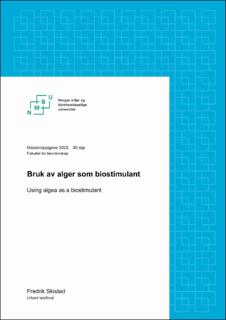| dc.contributor.advisor | Sheona Noemi Innes | |
| dc.contributor.advisor | Trine Hvoslef-Eide | |
| dc.contributor.author | Skistad, Fredrik | |
| dc.date.accessioned | 2024-04-10T16:28:21Z | |
| dc.date.available | 2024-04-10T16:28:21Z | |
| dc.date.issued | 2023 | |
| dc.identifier | no.nmbu:wiseflow:6987683:57050746 | |
| dc.identifier.uri | https://hdl.handle.net/11250/3125919 | |
| dc.description.abstract | I denne masteroppgaven ble et frysetørket algeprodukt av trådalgene Stigeoclonium sp (K-0018) og Oedogonium vaucheri (K-0094) benyttet som en biostimulant i dyrking av to ulike kultivarer av mikrotomat, ‘Micro Gemma’ og ‘Jochalos’. Plantene og algene ble dyrket i torv, kompostjord og i et hydroponisk oppsett. Frysetørket alge ble blandet inn i vekstmedium og plantene ble dyrket i 65 dager. Før frysetørking ble algene benyttet som et rensetrinn i regi av prosjektet ALGECO som har mål om å undersøke om alger kan bidra med å fjerne næringsstoffer fra avløpsvann og dermed danner en sirkulær økonomi innen rensing av avløpsvann og gjenbruk av næring. I dette prosjektet var målet å undersøke potensialet for videre bruk av de høstede algene som biostimulant i planteproduksjon.
Målene for oppgaven var å undersøke om algeproduktet påvirker tomatplantene som en biostimulant og hvordan kultivar og vekstmedium påvirker resultatet. Det ble sett på morfologiske faktorer, næringsinnhold og fotosyntetiske evner.
Resultatene viser potensiale for algeproduktet til å bidra positivt til vekst i mikrotomater, samt muligens øke fruktutbytte. Plantene som hadde fått produktet utviklet seg noe mer morfologisk, og viste bedre næringsopptak og fotosyntetisk kvanteutbytte. I hydroponisk oppsett er resultatene annerledes, der algene blant annet har påvirket biomassen negativt.
Videre bør det forskes på hvilke mekanismer som fører til at algene påvirker plantene. | |
| dc.description.abstract | In this master's thesis, freeze-dried algae product of the filamentous algae Stigeoclonium sp (K-0018) and Oedogonium vaucheri (K-0094) was used as a biostimulant in the cultivation of two different cultivars of microtomato, 'Micro Gemma' and 'Jochalos'. The plants were grown in peat, compost soil and in a hydroponic setup. Freeze-dried algae were mixed into the growth medium and the plants were grown for 65 days. Before freeze-drying, the algae were used as a purification step under the auspices of the ALGECO project, which aims to investigate whether algae can contribute to removing nutrients from wastewater and thereby form a circular economy within wastewater purification and nutrient reuse. In this project, the aim was to investigate the potential for further use of the harvested algae as a biostimulant in plant production.
The goals of this thesis were to investigate whether the algae product affects the tomato plants as a biostimulant and how the cultivar and growing medium affect the result. Morphological factors, nutrient content and photosynthetic abilities were looked at.
The results show potential for the algal product to contribute positively to growth in microtomatoes, as well as possibly increasing fruit yield. The plants that received the product developed somewhat more morphologically and showed better nutrient uptake and photosynthetic quantum yield. In the hydroponic setup, the results are different where the algae have, among other things, affected the biomass negatively.
Research should also be carried out into the mechanisms that lead to the algae affecting the plants. | |
| dc.language | nob | |
| dc.publisher | Norwegian University of Life Sciences | |
| dc.title | Bruk av alger som biostimulant | |
| dc.type | Master thesis | |
